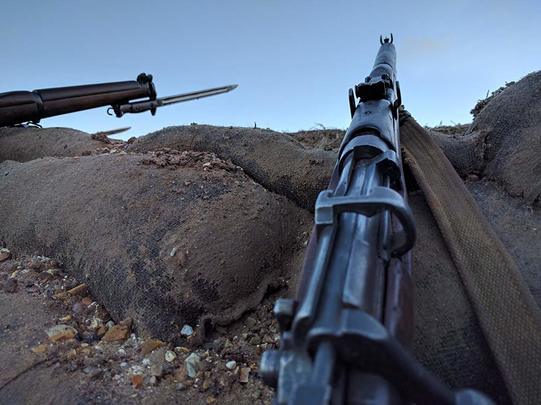JOURNEY'S END
****
Director: Saul Dibb
Screenwriter: Simon Reade, based on the play by R.C. Sherriff.
Principal cast:
Paul Bettany
Sam Claflin
Stephen Graham
Tom Sturridge
Asa Butterfield
Toby Jones
Country: UK
Classification: M
Runtime: 107 mins.
Australian release date: 8 November 2018
Previewed at: Dendy Newtown, Sydney, on 15 August 2018.
Journey’s End, directed by Saul Dibb and scripted by Simon Reade, is the fifth film adaptation of a play written by WWI veteran R. C. Sherriff and first performed on the London stage in 1928, starring a young Laurence Olivier. Set in March 1918 in the British trenches in northern France, this powerful portrayal of the precariousness of life on the frontline during World War I is thoroughly harrowing and convincingly conveys the utter despair that must have prevailed amongst the troops in such a surreal atmosphere, while all the time attempting to keep ‘a stiff upper lip.’
Many war films are shot in vast spaces, either on battlefields, open seas or skies. In this case, the battle for survival takes place in overcrowded, claustrophobic trenches, where men wade through mud, keeping their heads down low for fear of having them blown off by snipers, and the trench walls are packed with dead bodies shoring up areas that have eroded. A new arrival is informed of this fact and told not to worry about the smell. It seems these particular trenches were dug by the French forces and the bodies aren’t English servicemen. This knowledge makes for uncomfortable viewing and reinforces the daily misery the men were facing, even though there was a semblance of order in the officers’ dugout. Here, the upper ranks were attended to in a manner that befitted their status, albeit much scaled down as required by the circumstances. We are witness to four days in the life of ‘C’ Company, who are led by the weary, war-hardened, and now alcoholic, Captain Stanhope (Sam Claflin), who’s unnerved by the arrival of a new officer, Second Lieutenant Raleigh (Asa Butterfield), keen to serve under the Captain because he was, prior to the war, the young man’s former house master and the object of his sister’s affections. Stanhope is concerned that word of his alcoholism will get back to her. In the meantime, he is supported by his confidante, Lieutenant Osborne (Paul Bettany) and his needs are seen to by the long-suffering cook, Private Mason (Toby Jones), who somehow manages to keep food on the table and whiskey in his glass. Due to his superiors’ insistence on intelligence, Stanhope sends Raleigh on a seemingly hopeless mission with Osborne and a small group of men to capture a German soldier, in the hope that they will gain news about an attack due to commence any day and thus work out a strategy to combat the enemy. All the officers are aware that the raid is doomed to failure but the bright-eyed Raleigh is chuffed to have been selected for such a task.
Rather than depict blind patriotism or overt anti-war sentiment, Journey’s End shows the camaraderie and sheer bravery that existed under such fraught conditions. The fine ensemble cast is excellent, especially Claflin, Bettany and Butterfield, who are ably supported by Toby Jones, plus Stephen Graham and Tom Sturridge as 2nd lieutenants who are very much part of the action in the bunker. Although originally written for the theatre, the drama never feels ‘stagey’ and the location is genuinely authentic and grim - it’s an enclosed, hemmed-in set. The drama is enhanced by Icelandic composer Hildur Gudnadóttir’s music and Natalie Holt’s score, which are aptly mournful. The footage by Laurie Rose is realistically grimy, shot in a palette of muddy browns and khaki, as this is a colourless, bleak environment. Journey’s End is a fitting tribute in this centenary year marking the end of World War I and a sobering reminder that being in the trenches one would’ve felt one was experiencing “…the end of God in the poisonous shrapnelled air.” (Written by Britain’s Poet Laureate, Dame Carol Ann Duffy). It’s a powerful film.
